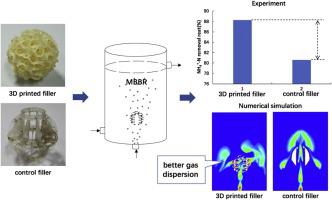Chemical Engineering and Processing: Process Intensification ( IF 4.3 ) Pub Date : 2020-09-14 , DOI: 10.1016/j.cep.2020.108146 Ajun wan , Yunpeng Wu , Yixuan Xie , Bi Zhao , Xiaolei Qi

|
A multi-channel wavy filler for moving bed biofilm reactor (MBBR) was prepared using 3D printing technology. The treatment effect of the 3D printed filler on simulated rural domestic sewage was tested and the control filler was a widely used multi-faced hollow ball filler. The results showed that the 3D printed filler has a biofilm formation rate more than 20 % higher than that of the control filler at the startup stage. The 3D printed filler works best when the aeration is 1–1.5 L/min, HRT is 4 h, and the pH is 7.5. The COD removal rate is 88.95 % and the ammonia nitrogen removal rate is 93.43 %. The effects of different fillers on the velocity field, vorticity distribution and gas phase distribution in the reactor were analyzed by numerical simulation. The compact and tortuous gully structure on the surface of the multi-channel wavy filler has a good cutting and breaking effect on the bubbles. Its gradually narrowed channel structure reduces the gradient of dissolved oxygen from the outside to the inside of the filler, providing a good environment for simultaneous nitrification and denitrification.
中文翻译:

使用3D打印填料的移动床生物膜反应器的实验研究和数值模拟
使用3D打印技术制备了用于移动床生物膜反应器(MBBR)的多通道波浪状填料。测试了3D打印填料对模拟农村生活污水的处理效果,对照填料是一种广泛使用的多面空心球填料。结果表明,在启动阶段,3D打印填料的生物膜形成率比对照填料高20%以上。当充气率为1–1.5 L / min,HRT为4 h,pH为7.5时,3D打印的填料效果最佳。COD去除率为88.95%,氨氮去除率为93.43%。通过数值模拟分析了不同填料对反应器内速度场,涡度分布和气相分布的影响。多通道波浪状填充物表面上紧凑而曲折的沟渠结构对气泡具有良好的切割和破碎效果。其逐渐变窄的通道结构减少了溶解氧从填料的外部到内部的梯度,为同时硝化和反硝化提供了良好的环境。



























 京公网安备 11010802027423号
京公网安备 11010802027423号